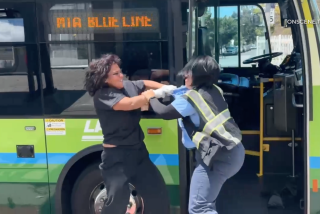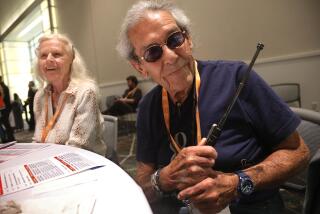3 Bus Riders With 3 Sides of the Coin
- Share via
When Catherine put her car up for sale with no intention of replacing it, her friends were convinced she was at best making an error and at worst just plain crazy. All of them worried that she wouldn’t survive without it.
Instead of buying another vehicle, the 74-year-old South Laguna resident plunked down a single dollar for an Orange County Transit District Bus Book. Then she took the bus to the bank and bought rolls of quarters, dimes and nickels. As simply as that, she says, her transportation problems were solved.
To celebrate, she took the little piece of paper that had given her the incentive to turn in her wheels--a $500-plus car insurance bill--and threw it in the trash.
“I’ve been driving since I was 35,” Catherine says. “And I have a good driving record. Perfect. Well, I got one ticket, but that was a long time ago, and I’ve only had one accident, when someone hit me. I just couldn’t see paying that much. So I thought, ‘I’ll give it a whirl.’ I figured if it didn’t work I could always buy another car.”
That was six months ago, and Catherine still hasn’t broken down and gone car-shopping. She did go and get her driver license renewed earlier this week--just in case--but so far she’s had no regrets.
“It’s an adventure,” she says. “And it’s cheap.” (The regular fare is 80 cents, but riders age 60 and older pay only a dime, or 40 cents during peak hours.)
“Oh, you have to be patient,” Catherine says. “When I go to visit my sister in Burbank, it takes six buses and six hours, each way. I told her that’s true love. But I don’t mind it at all. I like the idea of letting someone else drive. You can see the scenery. And I’ve met so many interesting people on the buses, riders who are visiting from other countries. It doesn’t take much to start a conversation. You just say something about the weather or ask how they like the area. So many of the Mexicans like to practice their English, so if you know a few words of Spanish, you can talk to them.”
Catherine is semiretired, and she concedes that does make bus riding more convenient for her because she has no daily commute. “I do have the time, that’s one thing,” she says.
She lives across the street from a supermarket, so she doesn’t have to worry about hauling bags of groceries on the bus. “I really feel sorry for people who have to do that,” she says. “But the bus is handy for other kinds of shopping. They go to all the malls.”
An Orange County resident off and on for 30 years, Catherine says: “Things have changed, really. When I first moved here, you had to have a car. But the bus system has certainly improved since then.”
Based on her own experiences, Catherine has this advice for potential bus riders: “Bring a book or newspaper to read. Be patient. Be a good sport, in case you miss a bus or it’s crowded or something. Be able to take things as they come. Check your schedule so you don’t waste a lot of time. Bring the right change.”
She also has some suggestions for the people at the Orange County Transit District: “They could wait for a connecting bus instead of leaving. Sometimes they do, and sometimes they don’t. Some of the drivers are really nice, but a few are kind of discourteous. They forget they’re serving the public.
“It’s also nice for the bus drivers to call out the streets. That really is helpful, especially for tourists.”
Florence, who lives in Huntington Beach, also rides the bus. But she isn’t the satisfied customer that Catherine is.
“I came here from New York eight years ago,” she says. “When on the East Coast, I did not drive either but had the option of using trains or buses. The procedure was not difficult and became quite routine.
“Since I arrived here, I find it difficult to get to a doctor, beauty salon, to shop and to socialize with friends or see a movie.
“The fact is no matter how near the destination, one must invariably take two buses. The closest routes operate 65 minutes or 30 minutes apart. So as you can see, it is indeed a hardship to exist without a car.”
Chuck, a La Habra resident, didn’t give up driving by choice. He lost the privilege thanks to a couple of drunk-driving convictions. At first he tried a bicycle, but then he switched to the bus. He not only found it convenient--”Fortunately, my life is in a pretty tight radius”--but relaxing. “No wonder these people go crazy on the freeway. There’s no reason to destroy an automobile and your sanity, too.”
After his license suspension expired, Chuck didn’t bother to go out and get another car.
He lives close enough to walk to the store for groceries, and to the Alcoholics Anonymous meetings that are so important in his life these days. “The only reason to ever have a car is for social purposes,” he wrote. “If I had planned it, things couldn’t have turned out better. Try walking in the morning, if just for exercise. Fellow walkers actually say, ‘Hi! Good morning!’ The buses are on time. Use the ride to read, relax. Leave the driving to the other fools.”
But a few days after he mailed that letter, Chuck was forced to reconsider. He broke his ankle (“I’ll have to write you another letter to explain that,” he says) and suddenly riding the bus doesn’t seem quite as convenient. With at least another month on crutches ahead of him, Chuck now says: “I’m thinking about buying a car, just an old clunker to get me around for a while. But if it weren’t for my injury, I’d probably just keep saving my money.”
More to Read
Sign up for Essential California
The most important California stories and recommendations in your inbox every morning.
You may occasionally receive promotional content from the Los Angeles Times.









